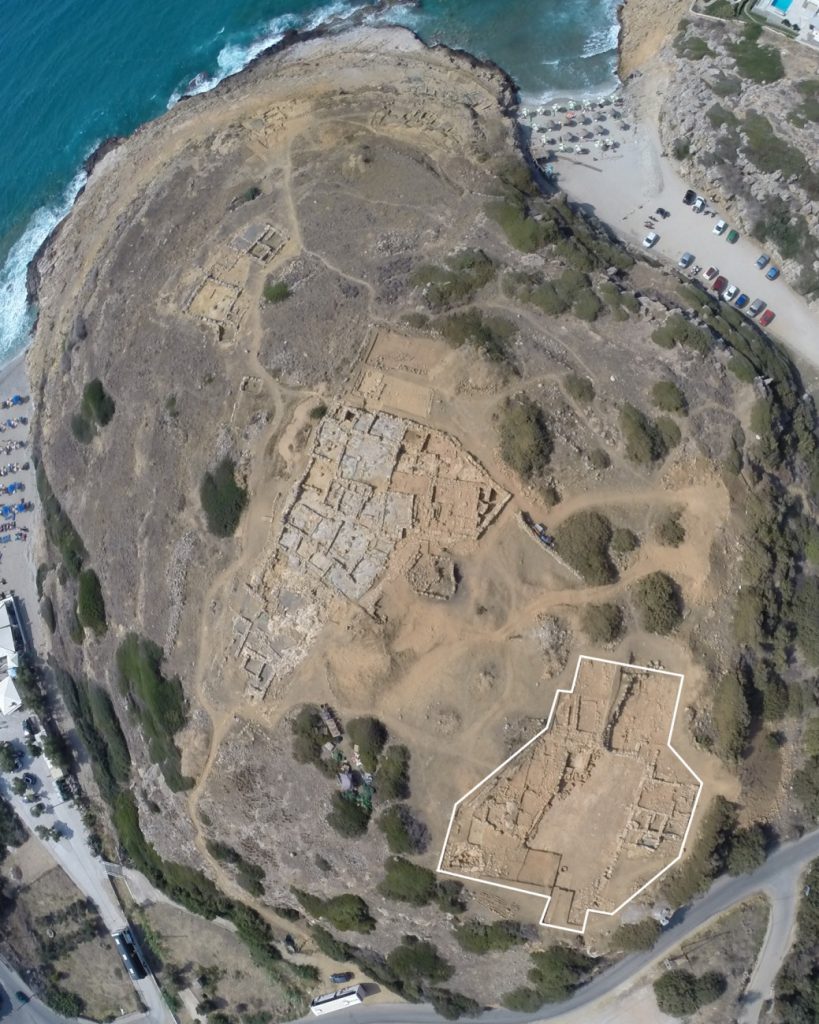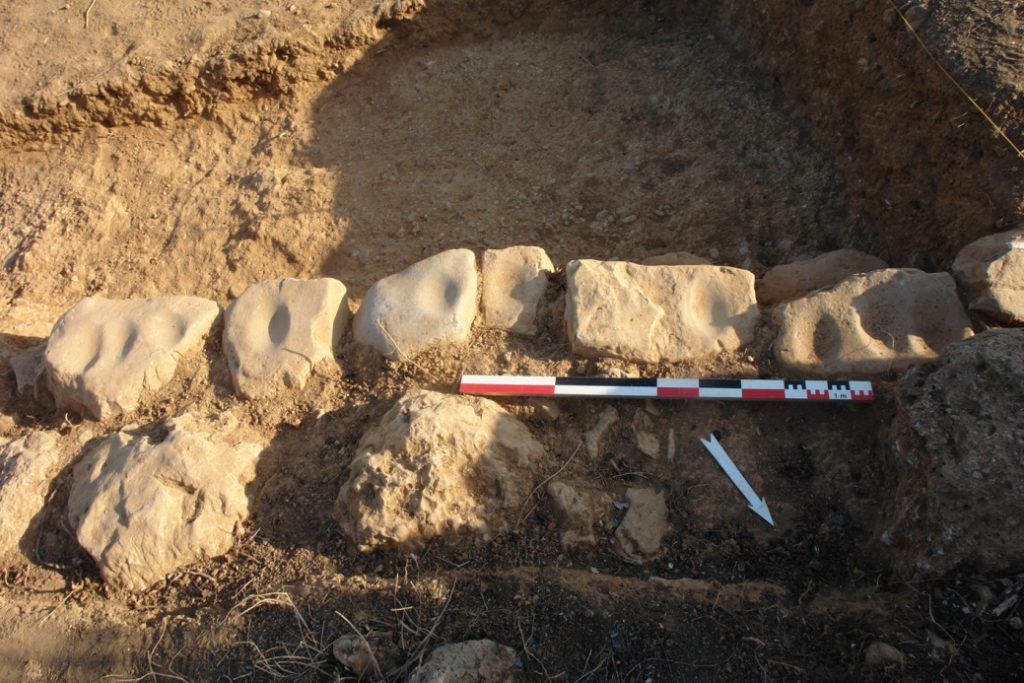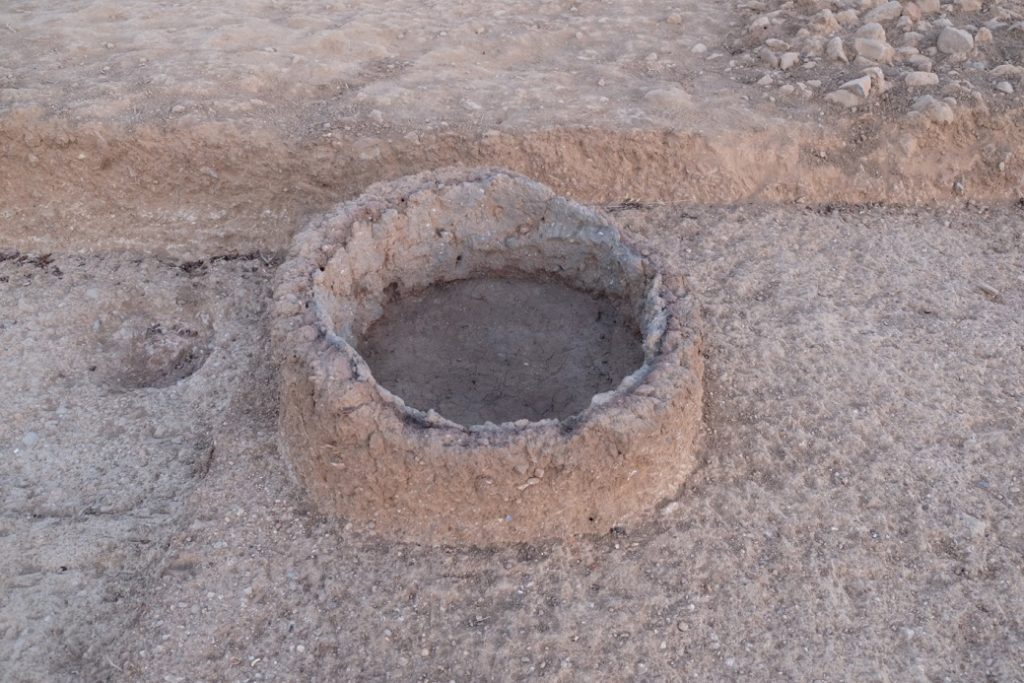The Court Building on the south-eastern terrace of the hill

Figure 1. Aerial view of the site, and the area excavated on the south-eastern part of the hill which revealed the presence of the Court Building ©Sissi project
Little remains indicated the presence on the south-eastern terrace of the hill of the Court Building which has been excavated since 2008 under the supervision of Dr. Simon Jusseret, later joined by Dr. Maud Devolder, Dr. Sylviane Déderix, and PhD candidates Thérèse Claeys and Ophélie Mouthuy (fig. 1). Excavation first concentrated on the easternmost part of the lower terrace where a few large blocks were visible on the surface. These blocks proved to belong to Building F, which was last occupied during the Postpalatial period. The reoccupation of the building eradicated some of the earlier plan and most of the earlier deposits within. It was only in 2011 that the west façade of Building F could be cleared. This façade was surprising because of several features: not only did it form a straight line of more than 20 m long, only interrupted by two entrances with substantial thresholds, but it also preserved a foundation of fine flat limestone blocks originally meant to carry an ashlar elevation, fragments of which were found collapsed to the West. Most remarkable was the presence, immediately south of one of the entrances, of a large stone kernos formed by an oblong limestone block, set on its own low platform, not unlike the finer example at nearby Malia (fig. 2).

Figure 2. The kernos along the west façade of Building F ©Sissi project
During the 2011 excavation campaign we explored the area immediately west of Building F and found a pebble-and-plaster surface, unusual as street cover but quite common where open courts are concerned. The façade and the court turned out to continue both to the north and south. We then opened a trench perpendicular to the northernmost part of the west façade of Building F and found an east-west wall of large limestone boulders with a bench against it (fig. 3). This bench has 12 artificial oval hollows, each about 10 cm in diameter, the purpose of which remains unclear. This east-west wall was found to abut to the west against a north-south running sandstone ashlar façade parallel to the west façade of Building F. It was only then that we started to conceive the possibility that we were in fact, unexpectedly, excavating a court-centred building. Excavations in 2015 and 2016 in this area confirmed this hypothesis, since a large court was brought to light, surrounded to the east, west, and north by different wings (fig. 4).

Figure 3. Bench forming the northern limit of the court ©Sissi project

Figure 4. Aerial view of the Court Building ©Sissi project
The court itself is made of plaster and pebbles (fig. 5). It is quite well preserved and it connects the different structures on three sides. It is at least 40 m long but no southern limit has thus far been found. In the current state of field work, the width of the court varies from only 9.60 m, to the very north, up to 15.30 m somewhere in its centre. In any case, it seems to have had a trapezoidal shape and to cover ca. 430 m². Apart from isolated sherds, nothing of interest was found on the surface of the court although we have hopes that, once processed, the archaeobotanical, phytolith, and micromorphological samples will provide information on the use of this open space.

Figure 5. General and detailed views of the surface of the court ©Sissi project
What we did find about 20 m south from the north bench and more or less in the centre of the court is a well-preserved circular structure of burnt clay. It has a diameter of a little less than 90 cm and it is preserved for a height of about 30 cm (fig. 6). There is no entry hole and it contained only burnt earth, ashes, and a few larger stones intentionally placed in it. There is no indication that the structure was domed. In shape and size, it resembles Levantine tabuns or tannurs, bread ovens in which the loaves were either stuck against the outside or the inside. Alternatively, it could also simply be some kind of lighting device. Its position, however, reminds one of the square built hearth in the middle of the court of the palace in nearby Malia.

Figure 6. Circular feature discovered in the south-central part of the court ©Sissi project
The East Wing
The East Wing, of which the north part was reused as Building F, is unfortunately not well preserved. It is clear, however, that the west façade of the southern part is constructed in a markedly different way from that to the north and described earlier, but the pebble-and-plaster court also stops against it. Bedrock outcrops in several places but Neopalatial pottery, including a small askos with spiral decoration and conical cups were found (fig. 7). One room preserved a fire destruction deposit. A test in another room came upon Prepalatial remains. In the east part is a channel-like depression, perhaps also to drain water. The most southern part of the façade marks a sharp turn towards the west, almost forming a rounded edge to the court at this side.

Figure 7. Askos from Building L ©Sissi project
The North Wing
The North Wing of the building has no traces of occupation later than Late Minoan IA in contrast to Building F. The eastern part of this North Wing is badly preserved because of agricultural activities and erosion but there is good evidence for architectural phasing. In the room with the column base is part of a floor made of terracotta slabs (fig. 8), and this is located on top of an earlier phase with similar terracotta slabs, presumably a rebuilding then after the Middle Minoan IIIA earthquake. The scanty architectural remains allow the identification of a double staircase and a long, wide corridor, originally paved. The number of fragments of plaster found in the west part of this wing, however, was impressive and suggests that the entire building was amply plastered. A fine stone drain with a clay gutter inside drained the Central Court between this east part and the East Wing (Building F) (fig. 9). It seems to have remained open till quite late.

Figure 8. Room 6.21 in the eastern part of the North Wing of the Court Building ©Sissi project

Figure 9. Stone drain with clay gutter between the North Wing and East Wing ©Sissi project
There is almost a 2 m difference between the east and the west part of the North Wing, which occupies a higher terrace. In between is a fine, paved corridor that connects the outside of the Court Building with the Central Court, the Northern Entrance Passage (fig. 10). There are some signs that this corridor was reconstructed or modified at some stage and between some paving slabs we found some Santorini tephra while in its south part, near the court, were fragments of a bull rhyton. The Northern Entrance Passage seems aligned with the top of the Selena Mountains in the distance. Within this west part of the North Wing are five rooms, also abandoned in the Neopalatial period. Against the west, rising bedrock, however, earlier Prepalatial remains were preserved, walled-in when the area was reconstructed in Middle Minoan IIIA. Further west, however, higher up the hill, the excavation brought to light extensive Prepalatial remains (see The Prepalatial Houses) and more were found in the West Wing of the Court Building.

Figure 10. Northern Entrance Passage connecting the outside to the Central Court ©Sissi project
The West Wing
The West Wing of the Court Building incorporated much of the Prepalatial remains (fig. 11), including an extensive obsidian deposit of more than 700 pieces, no doubt indicative of a workshop. But there were also goat horn cores, some gold foil, much pottery, including some pithos bases and several examples of Mottled Ware, an imitation of the famous Vasiliki pottery. Signs of a fire destruction in Early Minoan IIB are clear and these deposits are stratified between the bedrock ledge to the west and an impressive terrace wall to the east made of large boulders which seems to have played an important role in the architectural development of the court complex as a whole. Rather than tearing it down, the Neopalatial builders maintained it and structured the rest of the construction around it. Indeed, it formed the core for the Neopalatial reconstruction in this area.

Figure 11. Prepalatial deposit in the West Wing of the Court Building ©Sissi project
The West Wing proper has an ashlar façade to the south and west, partly built against the Prepalatial terrace wall. Both parts have a 45 cm first course of cut hard dark grey limestone and a 40 cm second course of sandstone ashlar. The most northern ashlar part, however, projects, enclosing a small room 6.17. Tests suggest that this room was first an open platform, accessible by three steps from the south and east (fig. 12). Only later, when an additional, higher platform was constructed south of it, provided with a staircase, which we found collapsed, were the earlier steps hidden. At least four wide steps can be reconstructed ascending to the higher platform and some of these were plastered. Both the higher platform and the elaborately decorated room 6.17 were placed in front of the Prepalatial terrace wall which, more to the south, is abutted by the continuation of the limestone and ashlar façade which runs for another 12 m before turning west (fig. 13). The south façade of the West Wing can be followed for a length of about 9 m until it stops against the rising bedrock to the west. Much of this southern façade is still plastered. Only some blocks of the sandstone second course of the façade are preserved while the rest collapsed on the floor level of the court. The Neopalatial phase within the West Wing is badly preserved and only Space 10.12 kept part of its plastered floor and a fire destruction.

Figure 12. The collapse of the west façade on the court and the rooms of the West Wing behind it ©Sissi project

Figure 13. Limestone and ashlar façade of the West Wing ©Sissi project
South of the West Wing proper is an area that seems originally devoted to water collection and storage (fig. 14). A water collection basin, cut out in the bedrock, is located immediately south of the ashlar south façade. This shallow basin was found packed with different layers of pottery, separated by thin lenses of plaster. Since most of the pottery studied by Iro Mathioudaki consists of drinking cups that can be dated to MM IIIA, MM IIIB, and a few to LM IA, we assume these cups were used in the successive drinking feasts that were organised in the court. The creation of this basin may go back to Middle Minoan IIB if not earlier. The final layer above the basin also comprised tephra lapilli from Santorini, an identification confirmed by Dr. C. Lane (Cambridge University). Apart from in this area and in the north corridor, no other tephra has been found within the buildings at Sissi, so it remains unsure whether the eruption caused the abandonment of the complex, or whether the building was already in ruins when the eruption occurred. When the basin was still functioning, it collected water that was drained out into a large underground space or cistern to the south. On excavation, this underground space was also found filled-in and packed with many sandstone ashlar blocks, intentionally deposited. These blocks are left west of the building. We assume that the dumped ashlar inside the cistern originally adorned the west façade of the West Wing. This cistern, together with some small rooms, seems to have formed an independent construction, which we have labelled the Basin Building. The orientation of this Basin Building differs from that of the Court Building and it could conceivably be somewhat earlier but the ashlar used in its reconstruction is identical to that used for the façades around the court. Tests in the area, however, have shown that some of its walls go down very deep and are associated with Middle Minoan IB sherds. Similar sherds were also found more to the south, below another finely paved corridor. This corridor – the Western Entrance Passage – also leads from the outside straight into the Central Court. Its walls are not well preserved but arriving at the Central Court, one can notice to the right a large stone platform, next to which we found a complete stone vase, while to the left, the court façade wall is formed by two upstanding stones with a small bench in front (fig. 15). We reconstruct these stones into horns of consecration, a typical Minoan religious symbol. Coming from the West Corridor too, one has a good view on the East Hills. These may have played a role in the Minoan calendar, showing the rising sun at a certain moment of the year (equinox/solstice).

Figure 15. Horns of consecration at the Western Entrance Passage ©Sissi project
South of the Western Entrance Passage is an area with a dozen or so small rooms. On excavation, these were all covered with a thick layer of stones, which may imply that they were already given up at an earlier moment, apart from the most western room, which is the only one which preserved a Neopalatial floor deposit with two pithoi, a bronze knife, a marble slab, and a few small pots. In the east part, only were remains of plastered floors. In one of these rooms, however, we noticed the plaster floor stopped in a semi-circular edge. We tested this and found a very large plastered cistern beneath (fig. 16). It has a diameter of about 5 m and a depth of ca. 2 m. The cistern had been filled in during MM IIIA-B, no doubt after the earthquake that is attested elsewhere on the site. But its construction dates at least to MM II, if not earlier. During its life, a partition wall was inserted within the cistern. We also found many pieces of thick tarazza which suggests the cistern had been roofed. A large clay slab found in the centre may originally have been a manhole cover, allowing water to be drawn.

Figure 16. Large plastered cistern south of the Western Entrance Passage ©Sissi project
The area south of the Central Court is rather odd (fig. 17). In its final Neopalatial phase, it comprised a series of small cells that did not communicate with each other. Perhaps they simply served as buttresses to retain the large terrace wall of the court. Tests showed that there were earlier remains at the lowest level, dating to Middle Minoan II. One of the rooms was then used as a potter’s workshop.

Figure 17. Area south of the Central Court with small cells ©Sissi project
It must be clear from this brief and preliminary description that there is surprisingly little evidence that helps us to understand the function of the complex apart from an obvious public ceremonial purpose. This is alluded to by the elaboration of the court with ashlar facades, the stepped platform, the presumed fire altar in its centre, but also by the stone kernos and the bench with hollows. As far as we can judge for the moment, the final complex was constructed in Middle Minoan IIIA but suffered from a Middle Minoan IIIA earthquake after which it was reconstructed, and we assume the ashlar was added at this moment. It was abandoned in Late Minoan IA, around the time of the Santorini eruption. In any case, the complex must have been in use in the same period as the palace at Malia, and it hence duplicates to some degree the ceremonial function of the latter which, at the least, suggests some regional decentralisation during the Neopalatial period. Tests have shown an earlier Middle Minoan I-II occupation in the same area, but it is too early to decide whether the remains formed a single structure and had a central court already.
Jan Driessen, Simon Jusseret, Maud Devolder, Quentin Letesson, Théo Terrana, Thérèse Claeys, Sylviane Déderix, Ophélie Mouthuy
– Retained images:
– Figure 1 (image001-819×1024.jpg)
– Figure 2 (image002-1024×683.jpg)
– Figure 3 (image003-1024×683.jpg)
– Figure 4 (image004-1024×978.jpg)
– Figure 5 (image005-1024×973.jpg)
– Figure 6 (image006-1024×683.jpg)
– Figure 12 (image012.jpg)
– Renumbered image:
– Figure 7 (previously Figure 15, image015.png)
– New images required (replace placeholders with actual file names):
– Figure 8 (new_image008.png) – Room 6.21 in the North Wing
– Figure 9 (new_image009.png) – Stone drain with clay gutter
– Figure 10 (new_image017.png) – Northern Entrance Passage
– Figure 11 (new_image018.png) – Prepalatial deposit in West Wing
– Figure 13 (new_image019.png) – Limestone and ashlar façade of West Wing
– Figure 14 (new_image020.png) – Water collection basin
– Figure 15 (new_image021.png) – Horns of consecration
– Figure 16 (new_image022.png) – Plastered cistern
– Figure 17 (new_image023.png) – Area south of Central Court